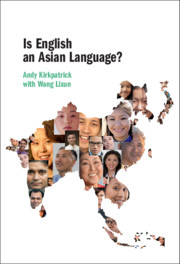27 results
11 - Conclusion
-
- Book:
- Is English an Asian Language?
- Published online:
- 15 October 2020
- Print publication:
- 29 October 2020, pp 196-201
-
- Chapter
- Export citation
2 - The Asian Corpus of English
-
- Book:
- Is English an Asian Language?
- Published online:
- 15 October 2020
- Print publication:
- 29 October 2020, pp 30-52
-
- Chapter
- Export citation
Dedication
-
- Book:
- Is English an Asian Language?
- Published online:
- 15 October 2020
- Print publication:
- 29 October 2020, pp v-vi
-
- Chapter
- Export citation
Contents
-
- Book:
- Is English an Asian Language?
- Published online:
- 15 October 2020
- Print publication:
- 29 October 2020, pp vii-vii
-
- Chapter
- Export citation
8 - English in Law, Religion and Popular Culture
-
- Book:
- Is English an Asian Language?
- Published online:
- 15 October 2020
- Print publication:
- 29 October 2020, pp 148-161
-
- Chapter
- Export citation
5 - The Transfer of Features and Communicative Strategies
-
- Book:
- Is English an Asian Language?
- Published online:
- 15 October 2020
- Print publication:
- 29 October 2020, pp 90-110
-
- Chapter
- Export citation
1 - How English Came to Asia
-
- Book:
- Is English an Asian Language?
- Published online:
- 15 October 2020
- Print publication:
- 29 October 2020, pp 12-29
-
- Chapter
- Export citation
Index
-
- Book:
- Is English an Asian Language?
- Published online:
- 15 October 2020
- Print publication:
- 29 October 2020, pp 217-220
-
- Chapter
- Export citation
7 - Non-standard Forms in Asian Englishes and ELF
-
- Book:
- Is English an Asian Language?
- Published online:
- 15 October 2020
- Print publication:
- 29 October 2020, pp 128-147
-
- Chapter
- Export citation
3 - Asian Varieties of English vs English as a Lingua Franca (ELF) in Asia
-
- Book:
- Is English an Asian Language?
- Published online:
- 15 October 2020
- Print publication:
- 29 October 2020, pp 53-70
-
- Chapter
- Export citation
6 - Borrowing Words and Writing Asian Englishes
-
- Book:
- Is English an Asian Language?
- Published online:
- 15 October 2020
- Print publication:
- 29 October 2020, pp 111-127
-
- Chapter
- Export citation
4 - What Do Asian Multilinguals Talk about When Using English as a Lingua Franca?
-
- Book:
- Is English an Asian Language?
- Published online:
- 15 October 2020
- Print publication:
- 29 October 2020, pp 71-89
-
- Chapter
- Export citation
Figures and Tables
-
- Book:
- Is English an Asian Language?
- Published online:
- 15 October 2020
- Print publication:
- 29 October 2020, pp viii-x
-
- Chapter
- Export citation
References
-
- Book:
- Is English an Asian Language?
- Published online:
- 15 October 2020
- Print publication:
- 29 October 2020, pp 202-216
-
- Chapter
- Export citation
Introduction
-
- Book:
- Is English an Asian Language?
- Published online:
- 15 October 2020
- Print publication:
- 29 October 2020, pp 1-11
-
- Chapter
- Export citation
9 - English as a Language of Education in Asia
-
- Book:
- Is English an Asian Language?
- Published online:
- 15 October 2020
- Print publication:
- 29 October 2020, pp 162-178
-
- Chapter
- Export citation
Copyright page
-
- Book:
- Is English an Asian Language?
- Published online:
- 15 October 2020
- Print publication:
- 29 October 2020, pp iv-iv
-
- Chapter
- Export citation
10 - Implications for English Language Teaching in Asia
-
- Book:
- Is English an Asian Language?
- Published online:
- 15 October 2020
- Print publication:
- 29 October 2020, pp 179-195
-
- Chapter
- Export citation

Is English an Asian Language?
-
- Published online:
- 15 October 2020
- Print publication:
- 29 October 2020
12 - What Is English in the Light of Lingua Franca Usage?
- from Part V - English in Lingua Franca Contexts
-
-
- Book:
- Ontologies of English
- Published online:
- 24 December 2019
- Print publication:
- 02 January 2020, pp 233-252
-
- Chapter
- Export citation

